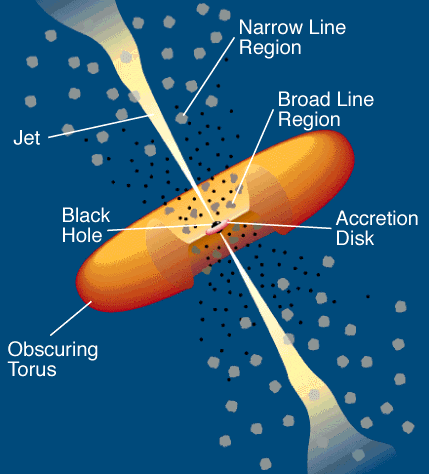|
|
| Is Blazar Flux Variation in Complete Electromagnetic Spectrum Intrinsic? |
 |
Text Size: A A A |
|
It is believed that blazars show flux variability in complete electromagnetic (EM) spectrum on all possible timescales varying from few minutes to several years. A recent study led by Alok C. Gupta, a visiting scientist of Shanghai Astronomical Observatory (SHAO) shows that blazars are not necessarily variable in all EM bands on all possible timescales. The result is accepted for publication in Monthly Notices of the Royal Astronomical Society. It is commonly accepted that supermassive black holes (SMBHs, with masses between 106 and 1010M⊙) are present in the nuclei of all galaxies with stellar bulges. At any given time, a few percent of these SMBHs are fed with a sufficient amount of gas that they will possess significant accretion discs. During the falling of the gas, its gravitational energy is converted into the internal energy thus strong radiation is emitted. This is the fundamental mechanism underlying so-called “active galactic nucleus” (AGN). A schematic diagram of AGN is shown in Figure 1. 
Figure 1. A schematic diagram of radio loud AGN (Figure courtesy : Urry & Padovani, 1995). A small subset of AGN are called blazars. Due to their strong and large amplitude variability nature in the entire EM spectrum, they are considered as transient astronomical objects. The radiation from blazars is dominated by non-thermal emission at all wavelengths, consisting of two broad spectral humps: a low-frequency component from radio to the UV/X-rays, generally agreed to be due to synchrotron radiation from relativistic electrons in the jet, and a high-frequency component from X-rays to gamma-rays, which is probably by inverse Compton (IC) mechanism. Based on the location of these spectral energy distribution (SED) peaks, blazars are further classified into low energy peaked blazars (LBLs) and high energy peaked blazars (HBLs). In LBLs the first SED component peaks in radio to optical and in HBLs the first component peaks in UV/X-rays. 
Figure 2. The location of peaks in the SEDs of the two kinds of blazars. Solid curves and long dashed curves show the synchrotron component of SEDs of LBLs and HBLs, respectively. This work is studying IDV in X-ray bands for LBLs and IDV in optical bands for HBL, as shown with the yellow shaded regions. Image by Zuo Wenwen. Study of flux variability is one of the most powerful tool for understanding the nature and processes occurring in blazars. Variation in the blazar flux of the order of a few hundredth to tenths of magnitude over a time scale of few minutes to less than a day is called intraday variability (IDV). Variability timescales of weeks to few months is commonly known as short term variability (STV) and timescales of months to years is called long term variability (LTV). In SED, the first synchrotron hump of the HBLs peaks in UV/X-rays and in IR/optical bands for LBLs. The peak of the SED seems to be responsible for variability properties of these classes of blazars in X-ray and optical bands. “By taking the advantage of a sample of 12 LBLs with total 50 observations from XMM-Newton since its launch, we confirm that this class is less frequently variable in IDV in X-ray bands. We found that out of 50 observational light curves, genuine IDV is present in only two of light curves, i.e., 4%. Similar results were obtained from our earlier optical IDV studies of HBLs where out of 144 light curves, only genuine IDV was detected in 6 light curves, i.e., ~ 4%”, the first author Dr. Alok C. Gupta said. He is a faculty member of Aryabhatta Research Institute of Observational Sciences (ARIES), Nainital, India. Currently, under Chinese Academy of Sciences (CAS) President International Fellowship Initiative (PIFI) program, he is visiting and researching at SHAO. Dr. Gupta explained, since X-ray bands lie below the peak of the SED of LBLs in the optical band, one expects that the electrons available for radiating optical light would have slower effect of variability on X-ray intra-day timescale. Hence, their intra-day variability in X-ray bands is reduced as compared to the variability in optical bands. Science Contact: Alok C. Gupta, Shanghai Astronomical Observatory & Aryabhatta Research Institute of Observational Sciences, alok@aries.res.in News Contact: Wenwen Zuo, Shanghai Astronomical Observatory, wenwenzuo@shao.ac.cn Link to the research paper: http://mnras.oxfordjournals.org/lookup/doi/10.1093/mnras/stw1667 Link to Shanghai Astronomical Observatory: www.shao.ac.cn |
|